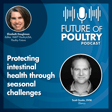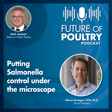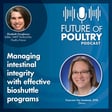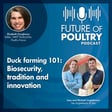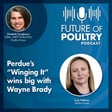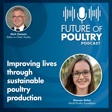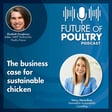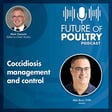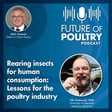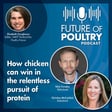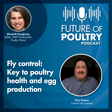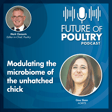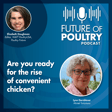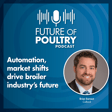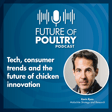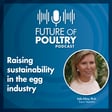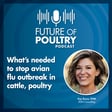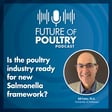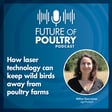Become a Creator today!Start creating today - Share your story with the world!
Start for free
00:00:00
00:00:01

Avian influenza update — focus on vaccination
Mark Clements, editor-in-chief, poultry, with WATT Global Media, welcomes Taoufik Rawi, DVM, Boehringer Ingelheim’s head of franchise global strategic marketing, poultry, to the podcast to examine the latest developments with avian influenza.
Transcript
Introduction to the Podcast
00:00:00
Speaker
Hello and welcome to the Future of Poultry podcast series.
00:00:12
Speaker
I'm Mark Clements, Editor-in-Chief Poultry, and today on the podcast, we're talking about avian influenza. The disease has moved from being seasonal to never really going away. While major outbreaks in the past peaked and then subsided, now the virus seems to be constantly with us.
00:00:28
Speaker
To look at why this is happening and how the industry might become more resilient, I'm very pleased to have Dr. Taufik Raui, Head of Franchise Global Strategic Marketing Poultry with Borenger Ingelheim, on the podcast today, who's going to talk us through why this change has happened and to share his insight on the French Avian Influenza vaccination campaign.
The Evolving Threat of Avian Influenza
00:00:50
Speaker
Taufik, welcome. Thank you so much for taking the time to join us today. Hi, Marc. Thank you so much for the invitation. I'm glad to be here and to have the opportunity to exchange with you on such an important topic.
00:01:02
Speaker
It's great to have you here, Taufik. As I mentioned in my introduction, Arabian influenza no longer seems to be seasonal. It now seems to be constantly with us. Can you tell us why this has happened?
00:01:14
Speaker
Yes, it's true. The highly pathogenic avian influenza is not strict longer strictly seasonal. In the past, we had outbreaks occurring mainly during autumn, and this was linked to the migration.
00:01:27
Speaker
So the birds were going down from the North Pole and they were bringing in the virus to our regions. Now we see the virus and outbreaks occurring outside of those usual periods.
00:01:41
Speaker
And this is a sign that the virus might be entrenched in some specific species or areas and spreading out of those species to potriflox. Most probably the reason behind this is linked to the fact that the virus itself evolved.
00:01:58
Speaker
Now we see that the actual clade, actual H5 clade that is circulating, is able to spread among higher number of bird species. The virus itself is much more infective.
00:02:11
Speaker
We need less number of viral particles in order to infect birds. And this gave the virus the ability to spread among areas that were not part of the original scope of the disease.
00:02:25
Speaker
And also, it explains the fact that we see outbreaks occurring outside of those original or usual periods of infections.
Impact on Wildlife and Livestock
00:02:35
Speaker
And I understand that the virus's entry into seabirds has been critical in this.
00:02:39
Speaker
Absolutely. So originally the virus that was circulating between 2014, 2015 and 2016, previous H5 clade that was circulating globally was able to infect more or less 30 bird species.
00:02:55
Speaker
The actual avian influenza clade is able to infect more than 380 species, including seabirds. And the fact that the virus is able to get in seabirds allowed the disease to spread to new geographies.
00:03:10
Speaker
That is the case, for example, for South America. Before, we had only few outbreaks reported in South America, but Since the virus was able to move to seabirds, we saw the number of outbreaks increasing tremendously in South America, especially in the coastal areas, which aligns with seabirds, rightways and nesting sites.
00:03:32
Speaker
It had also implications on sea mammals. So we remember all those infections that occurred in sea lions and seals, probably through feeding when those animals were feeding on infected birds.
00:03:45
Speaker
And we are seeing ever more mammals being infected. Yeah, we just mentioned the case of sea mammals in South America. The case of cattle, for example, in the US is also another striking one.
00:03:57
Speaker
So the infection in the US moved to cattle herds and now cattle to cattle transmission is established. So there is today ah dedicated plan to monitor the infection in cattle in the US.
00:04:11
Speaker
And Beringer is absolutely engaged with the US government on efforts to develop a vaccine for dairy
Advancements in Vaccination Technology
00:04:17
Speaker
cattle as well. So this change is happening.
00:04:21
Speaker
Still, we hear a lot about infections, for example, in humans. This is something that is not new. We had in the past other viruses spread into humans. The risk remains low. If we turn to vaccination, there were and there still are reservations about it.
00:04:35
Speaker
But the fact is that vaccines have changed and many of the previous challenges associated with vaccines don't really occur with modern vaccines. Absolutely. So previous generation vaccines are mostly based on the inactivated technology.
00:04:52
Speaker
Those vaccines are not DIVA compatible. but DIVA is the ability or differentiation between the vaccinated birds and infected birds. And it's extremely important in order to implement proper surveillance program.
00:05:06
Speaker
The new generation vaccines are based on different technologies. We have in one hand the subunit vaccines, where you have only one part of the virus that is expressed.
00:05:17
Speaker
And this allows a differentiation between vaccinated and infected birds. And we have also the vector vaccines that are also enabling this differentiation. Another important aspect is related to vaccine efficacy.
00:05:31
Speaker
And basically, the new generation vaccines are providing higher level of efficacy against the circulating clades. And we have today vaccination programs that are protecting against shedding, reducing the viral shedding after infection, but also protecting against viral transmission.
00:05:50
Speaker
And this is extremely important when we want to implement vaccination or integrate vaccination within a whole control program. So tell me about Böhringer's vaccine offer, if you would.
00:06:02
Speaker
Absolutely. So in actual H5 vaccine portfolio that is owned by Böhringer, we do have three different vaccines. One being four-box vector vaccine that was developed several years ago and that is used mainly in Mexico.
00:06:19
Speaker
We do have a subunit and activated vaccine based on a baculovirus technology that is called Volvac-Pest and this vaccine is the one that is used in Europe today in the vaccination in France program. And lately we launched a new HVT vector vaccine that is called Vexitec HVT-IVDH5 that has very specific feature.
00:06:40
Speaker
The H5 is based on what we call COBRA technology, computationally broadly reactive antigen that is allowing a cross-clade protection, a wide protection.
00:06:51
Speaker
The three vaccines are DIVA compatible, so they can be used as part of comprehensive prevention control or control program against avian influenza.
00:07:04
Speaker
Okay, thank you.
France's Vaccination Program Success
00:07:05
Speaker
Now, A number of countries have been vaccinating against having an influenza for years, but it's been France's Dove vaccination programme that's caught the headlines more recently, and you were involved in that.
00:07:18
Speaker
Absolutely. So France launched a vaccination campaign in DAX in 2023, following several trials that were implemented. by the French government in order to understand a little bit more the way vaccines are behaving in DAX.
00:07:32
Speaker
And then the French government issued a tender. Boehringer was chosen as the sole supplier for vaccine in the first tender. And then in the second tender, Boehringer was still chosen as one of the two companies that were supplying vaccines for the vaccination.
00:07:48
Speaker
The vaccination program as it is implemented in France is based on a couple of injections for those vaccines in DAX. And we are seeing so far good results out of this vaccination program.
00:08:01
Speaker
So the campaign's been pretty successful. Yeah, absolutely. What we are hearing and the information we receive from different stakeholders is very positive. Maybe the main indicator that is i measurable regarding the efficacy of those vaccination programs, the vaccination index in France is the number of outbreaks that is reported.
00:08:23
Speaker
Basically, if we look at the number of outbreaks that were reported by France The year before the implementation of the vaccination, it was, depending on the period that you are taking into account, but this was more or less 400 outbreaks.
00:08:40
Speaker
The first year after vaccination implementation, This number decreased tremendously to around 20 outbreaks. And even in the last flu season, that is starting from September till now, overall France declared 40 outbreaks.
00:08:58
Speaker
While in other European countries, we see an increase in the number of reportings. And this shows the positive impact of the vaccination program in the protection of the flux.
00:09:08
Speaker
But to look at a negative aspect, the vaccination campaign did impact trade, did it not, at least at the start of the campaign? Yes, trade remains the most important barrier to HPI vaccination overall.
00:09:23
Speaker
So the example of France is also extremely informative in that regard, as several countries did ban the French poultry products after the country launched the vaccination.
00:09:35
Speaker
But in parallel of vaccination implementation, France France implemented as well a very strong surveillance program that is ensuring that no HPI virus is circulating in the vaccination flux. This approach of combination between vaccination and the adequate surveillance was able to reopen several markets to France exports.
00:10:00
Speaker
That was the case for the US, for Canada and also for UK. Boehringer was involved with the campaign from the very start. Could you detail the company's involvement for our listeners? It was more than simply supplying vaccine, i understand.
00:10:14
Speaker
Yeah, absolutely. So what we did first is to provide the different stakeholders that were making assessment or that were in charge of the assessment of the vaccination program in France government with the in-depth information about our vaccines.
00:10:32
Speaker
We were also so supporting the implementation of the lab trials in order to build more knowledge about the vaccines, in order to understand a bit more how we can use those vaccines in that population.
00:10:44
Speaker
And then we were also part of those tenders in order to supply the vaccines. And I understand that the Netherlands is now also considering vaccination and I'm assuming that France will continue with its campaign, given the success that you've detailed.
Global Vaccination Strategies and Challenges
00:10:59
Speaker
Do you see vaccination being more widely adopted around the world? A number of countries certainly seem to be warming to it. So first, what we have to highlight in the last two or three years is the change, is a complete shift in the regulatory environment.
00:11:18
Speaker
All global regulators are today advocating for integration of vaccination in the control programs. This is extremely important to allow countries to start making the assessment of integrating vaccination, depending on epidemiological situation, trade, etc.
00:11:37
Speaker
Within Europe, Netherlands has recently, after the conclusive lab trials that were implemented last year, initiated controlled field study test, layers, and probably other countries are making the same assessment as we are speaking now, as we see strong impact, especially this year, of avian influenza virus on poultry production.
00:12:02
Speaker
And looking beyond Europe, there are a number of countries that have been vaccinating for decades and they've been quite successful. So vaccination against avian influenza might have different objectives.
00:12:14
Speaker
If we are in endemic country, the objective of vaccination is to safeguard the ability of the industry to produce pultry proteins. So in this case, vaccines are really used in order to protect against mortality and clinical science.
00:12:28
Speaker
This is the case for several countries around the world that are using those vaccines in that end. Another objective is to use the vaccines as a support to the control strategy of avian influenza.
00:12:41
Speaker
In this case, we will have golden triangle that should be implemented. First, a strong biosecurity, vaccination and an adequate surveillance program, of course, combined with stamp-in-out policy.
00:12:54
Speaker
And in this case, vaccination is mostly used for its ability to reduce shedding in case of infection and protection against disease transmission.
00:13:04
Speaker
Looking to the future, do you see a time when vaccination becomes standard practice worldwide? What we see now is these signals that are coming from the global regulators.
00:13:16
Speaker
The virus is here to stay, is acquiring more and more ability to spread among birds and other animals. So this restrains our possibilities when it comes to disease management without vaccination.
00:13:33
Speaker
So vaccination will be more and more integrated within the control strategies. We know that all producers should be practicing good biosecurity, but is there any particular advice that you would give producers to help them keep avian influenza off their farms?
00:13:50
Speaker
Yeah, biosecurity is a must and is the base of this triangle that we were mentioning with vaccination and surveillance. So both biosecurity and vaccination are there to decrease the infection risk, while surveillance will ensure that all affected flux are detected.
00:14:09
Speaker
and eventually stand out. But biosecurity a must not only for avian influenza but for the control or all of all of the other infectious diseases. Of course. So whether country should adopt vaccination or not is really not a straightforward question but as we discussed controlling it without vaccination is proving to be ever more difficult.
00:14:32
Speaker
Neither us have a crystal ball, but how do you think that the industry would need to adapt or will need to adapt if vaccination is not more widely practiced? What we saw over the past years is that avian influenza epidemics kept coming in waves and the waves are stronger We have more outbreaks and the losses are even bigger with the new clades that are circulating.
00:14:58
Speaker
The actual epidemic is deeply impacting the poultry industry and this represents a clear risk in the poultry production and ability produce the poultry proteins that are needed by the countries.
00:15:11
Speaker
Without vaccination, we are risking to have a decrease in our ability to produce poultry. The use of adapted vaccines, in the other hand, can help us support the sustainable production of poultry proteins.
00:15:27
Speaker
And this will also reduce the risk for spread of the virus to other bird species, to other animals. Overall, a vaccination program against avian influenza will prevent the outbreaks, reduce the economical losses,
00:15:41
Speaker
and prevent this environmental impact of the disease.
Conclusion and Future Insights
00:15:45
Speaker
Telfic, thank you so much for joining the Future of Poultry podcast today and sharing your insight with us. I hope that we can talk again soon to see how the avian influenza situation has developed.
00:15:57
Speaker
Thank you very much, Mark, for the invitation. And also thank you to our listeners as well. It was real pleasure to come and update you on this Avian Influenza topic that is today extremely, extremely important for our industry.
00:16:13
Speaker
Thank you, Tafik. Listeners, thanks to you for joining us today. You can find daily updates on avianinfluenza at wildpoultry.com. And remember to look out for future editions of the Future of Poultry podcast.
00:16:26
Speaker
Goodbye.
